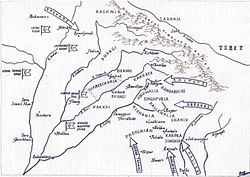Ahluwalia Misl | |||||||||
|---|---|---|---|---|---|---|---|---|---|
| 1774–1846 | |||||||||
 Ahluwalia Misl in 1780 | |||||||||
| Status | Part of the Sikh Confederacy (1774–1801) Under the Sikh Empire (1801–1846) | ||||||||
| Capital | Kapurthala | ||||||||
| Common languages | Punjabi | ||||||||
| Religion | Islam (Majority) Sikhism (State Religion) Hinduism | ||||||||
| Government | Misl | ||||||||
| Sardar | |||||||||
• 1777-1783 | Jassa Singh Ahluwalia | ||||||||
• 1837-1852 | Nihal Singh | ||||||||
| History | |||||||||
| 1774 | |||||||||
| 1846 | |||||||||
| |||||||||
| Today part of | |||||||||

Ahluwalia (also transliterated as Ahluvalia) was a misl, that is, a sovereign state in the Sikh Confederacy of Punjab region in present-day India and Pakistan. The misl's name is derived from Ahlu, the ancestral village of the misl leaders. The Ahluwalia misl was one of the 12 major Sikh misls, and held land to the north of Sutlej river. [4]
Contents
- History
- Origins
- Conflict with Sikh Empire
- Princely state
- Territory
- Dynasty
- Ahluwalia Misl
- Kapurthala State
- Gallery
- References
| Misls of the Sikh Confederacy |
|---|
 |




